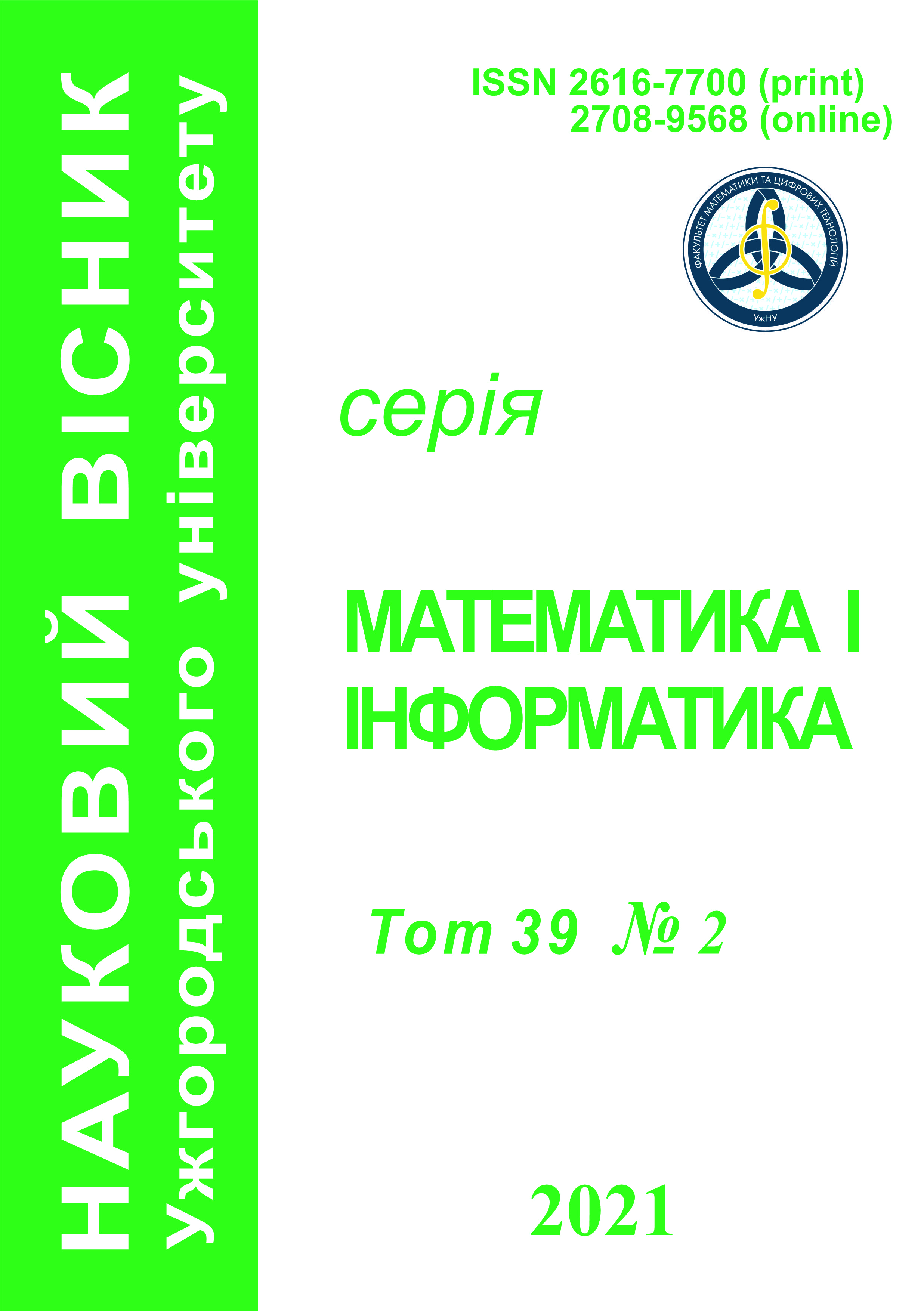Аналіз парадигми Semi-supervised learning для класифікації мультимодальних даних
DOI:
https://doi.org/10.24144/2616-7700.2021.39(2).125-144Ключові слова:
навчання під наглядом, метод опорних векторів, трандуктивний метод опорних векторів, метод опорних векторів для часткового навчання, прикладний програмний інтерфейсАнотація
У роботі розглядаються алгоритми машинного навчання. Увага зосереджена на напівконтрольному навчанні, яке здається балансом між точністю навчання з учителем та витратами методів навчання без учителя. Розглядаються приклади ретельного опрацювання мічених наборів даних, для яких навчання під наглядом може бути дуже ефективним. Порівнюються підходи semi-supervised та supervised та проаналізована ефективність кожного. В роботі розглядаються підходи S3VM та TSVM. Метою роботи було дослідити чи можуть напівконтрольовані підходи конкурувати з контрольованими або навіть їх перевершити. Описується застосування даних підходів до запропонованого датасету для визначення більш точної класифікації даних, а саме на опорній межі.
Посилання
- Estivill-Castro, V., & Lee, I. (2000). Amoeba: Hierarchical clustering based on spatial proximity using Delaunay diagram, in: 9th Intern. Symp. on spatial data handling, Beijing, China. 26-41.
- Boehm, C., Kailing, K., Kriegel, H., & Kroeger, P. (2004). Density connected clustering with local subspace preferences, IEEE Computer Society, Proc. of the 4th IEEE Intern. conf. on data mining, Los Alamitos. 27-34.
- Boyko, N., & Shakhovska, K. (2018). Information system of catering selection by using clustering analysis, in: 2018 IEEE Ukraine Student, Young Professional and Women in Engineering Congress (UKRSYW). Kyiv, Ukraine. 7-13.
- Harel, D., & Koren, Y. (2001). Clustering spatial data using random walks, in: Proc. of the 7th ACM SIGKDD Intern. conf. on know ledge discovery and data mining. San Francisco, California. 281-286.
- Tung, A.K., Hou, J., & Han, J. (2001). Spatial clustering in the presence of obstacles, in: The 17th Intern. conf. on data engineering (ICDE'01), Heidelb erg. 359-367.
- Boyko, N., Bronetskyi, A., & Shakhovska, N. (2019). Application of Artificial Intelligence Algorithms for Image Processing, in: CEUR. Workshop Proceedings of the 8th International Conference on Mathematics. Information Technologies. Educational, MoMLeT&DS-2019, Vol-2386 urn: nbn: de: 0074-2386-1, Shatsk, Ukraine, June 2-4, 2019, 194-211.
- Agrawal, R., Gehrke, J., Gunopulos, D., & Raghava, P. (2005). Automatic subspace clustering of high dimensional data, Data mining knowledge discovery, 11(1), 5-33.
- Ankerst, M., Ester, M., & Kriegel, H. P. (2000). Towards an effective cooperation of the user and the computer for classification, in: Proc. of the 6th ACM SIGKDD Intern. conf. on knowledge discovery and data mining. Boston, Massachusetts, USA. 179-188.
- Zhang, C., & Murayama, Y. (2000). Testing local spatial autocorrelation using. Intern. J. of Geogr. Inform. Science, 14, 681-692.
- Estivill-Castro, V., & Lee, I. (2000). Amoeba: Hierarchical clustering based on spatial proximity using Delaunay diagram, in: 9th Intern. Symp. on spatial data handling. Beijing, China. 26-41.
- Guo, D., Peuquet, D. J., & Gahegan, M. (2003). ICEAGE: Interactive clustering and exploration of large and high-dimensional geo data, Geoinformatica, 3(7), 229-253.
- Boyko, N., & Basystiuk, O. (2018). Comparison Of Machine Learning Libraries Performance Used For Machine Translation Based On Recurrent Neural Networks, in: 2018 IEEE Ukraine Student, Young Professional and Women in Engineering Congress (UKRSYW). Kyiv, Ukraine. 78-82.
- Aggarwal, C., & Yu, P. (2000). Finding generalized projected clusters in high dimensional spaces, in: ACM SIGMOD Intern. conf. on management of data. 70-81.
- Thanki, R., & Borra, S. (2019). Application of Machine Learning Algorithms for Classication and Security of Diagnostic Images, Machine Learning in Bio-Signal Analysis and Diagnostic Imaging, 273-292.
- Peuquet, D. J. (2000). Representations of space and time. N. Y.: Guilford Press.
- Procopiuc, C. M., Jones, M., Agarwal, P. K., & Murali, T. M. (2002). A Monte Carlo algorithm for fast projective clustering, in: Intern. conf. on management of data, ACM SIGMOD, Madison, Wisconsin, USA. 418-427.
- Chitra, K., & Maheswari, D. (2017). A Comparative Study of Various Clustering Algorithms in Data Mining. International Journal of Computer Science and Mobile Computing, 6(8),. 109-115
##submission.downloads##
Опубліковано
Як цитувати
Номер
Розділ
Ліцензія
Авторське право (c) 2021 Наталія Бойко

Ця робота ліцензується відповідно до Creative Commons Attribution 4.0 International License.
Автори залишають за собою право на авторство своєї роботи та передають журналу право першої публікації цієї роботи на умовах ліцензії Creative Commons Attribution License, котра дозволяє іншим особам вільно розповсюджувати опубліковану роботу з обов'язковим посиланням на авторів оригінальної роботи та першу публікацію роботи у цьому журналі.








